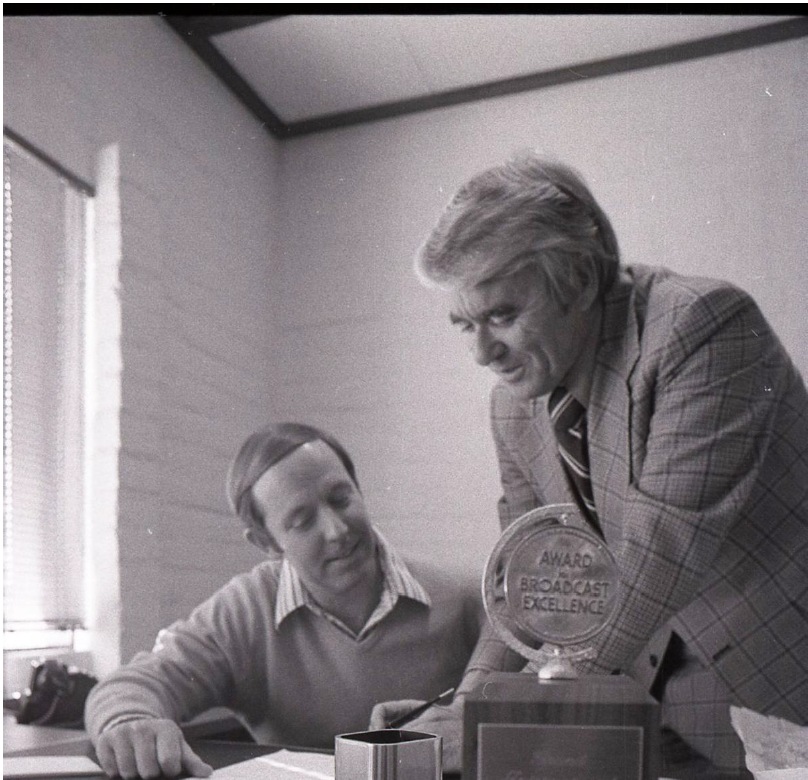 I'm right again dot com
I'm right again dot com
A Digital Publication of The Anonymous Anything
Society- August 10, 2018
Neto's Tucson:
Radio frequencies flow in Phil Richardson's veins
Ernesto Portillo Jr. Arizona Daily Star Jul 29, 2018
It began way early for Phil Richardson. He was a
kid growing up in Illinois, the son of a coal
miner, when he heard his first radio broadcast.
An uncle had built a rudimentary radio, “the kind
that Marconi built,” said Richardson, referring to
the Italian engineer and inventor who was one of
the early inventors of radio.
It was the early 1930s and the country and the
world were struggling to emerge from the global
economic collapse. What drew families together was
the radio. Families would gather around a radio,
sitting on the floor or a chair, to listen to
serial programs, news reports, sporting events.
And when radios began to appear on store shelves
or in the old Sears Roebuck catalog, “We lobbied
our father to get a new one, a Zenith,” said
Richardson, who then asked me: “Do you remember
Zenith?”
The radio bug had bitten the young Richardson, who
tinkered with radios, taking them apart and
putting them back together and repairing them. He
thought he would follow an older brother who went
to college, earned a degree in engineering and
ended up on a military base.
Instead, Richardson volunteered for the Army and
celebrated his 18th birthday in the Philippines —
the day the Japanese surrendered to end World War
II.
As he approaches his 91st birthday, Richardson
remains enamored with radio. On his small,
hand-held radio sitting on his kitchen table in
his northwest-side home, classical music plays
when he turns it on. In another room is his
amateur radio, which he uses to communicate with
fellow ham operators around the globe.
Open up his veins and radio frequencies are sure
to flow. Get him to talk about his life in radio
and a marathon talk session will ensue.
Understandably, because there is a lot to talk
about from the years Richardson spent working in
radio in Tucson, first with the rockin’ and
rollin’ KTKT in the 1960s, and in the 1970s with
country king KCUB, which one year earned national
kudos.
“This was the apex of my life,” said Richardson,
who nowadays dabbles as a writer. He has two
self-published books of fiction and is writing
about his life.
His radio days in Tucson began in 1960.
Richardson, who was working at a Phoenix radio
station, was lured to become KTKT’s general
manager about the time the station went 24/7. The
station’s studio and office were located in the
downtown basement of the Arizona Land Title
Building at Stone and Alameda. And one of his
first decisions was not to change anything.
KTKT, with DJ sensation Frank Kalil holding down
the 3 p.m. time slot, was king of Tucson radio
with its “Color Radio” format, when radio shed its
all-white play list and incorporated R&B music by
black artists.
Richardson knew better than to tinker with a good
thing. “It was a cannon, already loaded. I just
lit the fuse,” he said.
As general manager, Richardson oversaw the
station’s decade-long dominance in Tucson with its
Top-40 hits format and local news reporting by
radio personalities — Kalil, Jerry Stowe, Ray
Lindstrom, Tom Madison and Dick Nelson, among
others, and news reporters John C. Scott and Gene
Adelstein, to name a couple.
By the early ’70s, when the Beatles and Marvin
Gaye had replaced early ’60s favorites Percy Faith
and the Everly Brothers, Richardson did opt for
change. In 1971 he moved to KCUB to be the sales
manager, where he teamed up with general manager
and part owner Jim Slone.
KCUB occupied the bottom of the ratings rungs, but
by 1976 was not only Tucson’s top radio station,
but named by Billboard magazine as the Grand
International Station of the Year.
In addition to his sales duties, Richardson
reported the news and read editorials on KCUB.
This led him to become more politically involved
in Tucson. Richardson was already fully engaged in
civic life, serving on various boards and
commissions, but in the mid-’70s he helped lead a
move to recall Tucson City Council members because
of their decision to raise water rates.
Richardson would eventually have a slice of the
ownership in KCUB, but after 10 years he moved
over to KVOA, Channel 4, as editorial director in
1982.
He would end his years in the broadcast business
when he led a group to apply for a radio license
for Spanish-language station KQTL. He sold his
interest in KQTL before it went on the air in
1985.
“One thing for certain, though,” wrote David
Hatfield, the Arizona Daily Star’s
radio/television columnist, in 1982, “A lot of
people in Tucson know Phil.”
Commercial radio has radically changed since
Richardson’s early hard-charging days. Radio
stations are in the hands of out-of-town corporate
entities, programming is decided with algorithms,
and radio personalities have been drowned out by
social media chatter.
Richardson has more to say about Tucson and radio.
Here’s hoping he’ll finish his book.
Ernesto Portillo Jr. is editor of La Estrella de
Tucsón. He can be reached at 573-4187 or
netopjr@tucson.com.
 I'm right again dot com
I'm right again dot com